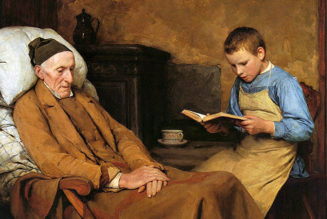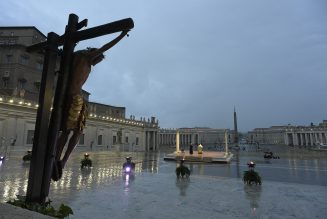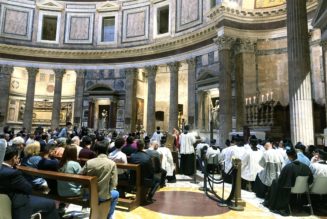While Lisbon’s World Youth Day is over, debate lingers over some liturgical decisions made during the week-long festival held for Catholic pilgrims from around the world.
Pope Francis has said that Lisbon was the most well-organized World Youth Day he has seen as pope, but some Catholics are calling foul, with controversy brewing on social media over the treatment of the Eucharist in Lisbon.

There were two main points of contention. One has to do with the ciboria used at a Mass connected to World Youth Day. The other has to do with the way the Eucharist was stored during the all-night vigil before the Aug. 6 final Mass.
While in some publications the two are being conflated, they were actually separate incidents.
Cellophane-covered ciboria
The first began when photographs of ciboria full of consecrated hosts, and covered in cellophane, began to circulate online. According to some, these were “Ikea potato chip bowls” that had been purchased at the last minute to distribute Communion.
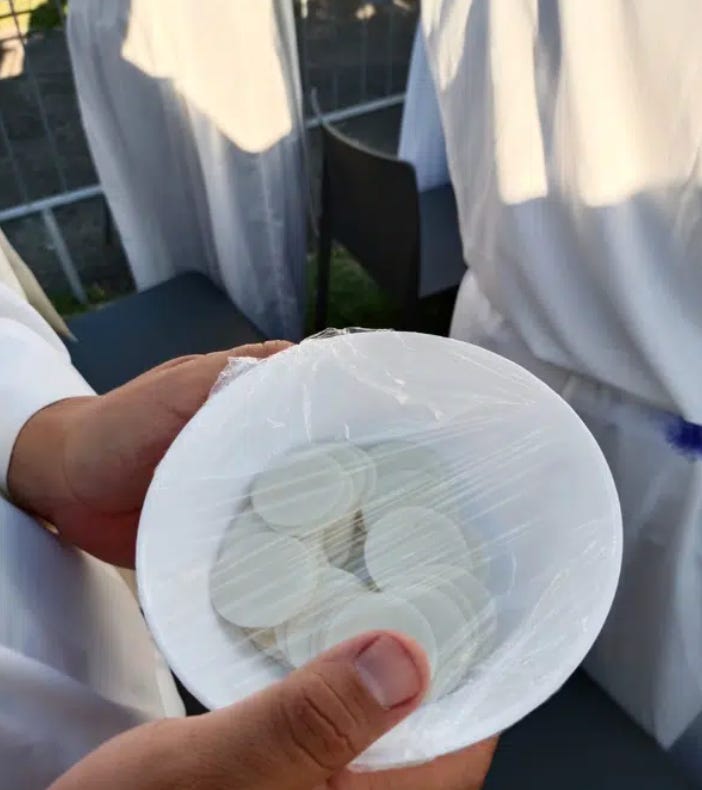
In fact, the Ikea ciboria were used during a Mass organized by the very large Spanish contingent — not in a Mass organized by World Youth Day itself. Forty thousand pilgrims participated in the open-air Mass held in a park in Estoril, by the sea, which was not officially a part of World Youth Day.
Fr. Nuno Coelho, a pastor in Cascais, near Estoril, was a World Youth Day liaison to the Spanish pilgrims.
He told The Pillar that the group brought their own ciboria to Portugal.
“From what we gathered, these are the ciboria that the Spanish [bishops’ conference] youth apostolate generally uses for large outdoor Masses. They look a little like breakfast bowls,” he said.
“The official WYD ciboria were designed by artisans, they are made of silver plate and they have a sliding articulated lid, to protect the consecrated hosts from the wind during distribution. The Spanish ones had no covering, but there was a very strong wind in the park, so they had them covered in plastic film to protect the hosts.”
“I left strict instructions to collect all the plastic film after the Mass, and it was burned, because it had been in contact with Our Lord,” the priest explained.
As to the ciboria themselves, the Spanish delegation kept them, Coelho said, except for a few in which unused consecrated hosts were held, which were taken to the tabernacle of a local parish immediately after the Mass in which they were used.
Coelho said those ciboria left in Portugal won’t be used again in liturgies.
“We have them kept away. We won’t be using them, but we’ll make sure they are respectfully stored, so they don’t get used for any secular purpose either,” the priest said.
The Eucharist in plastic boxes
The second contentious issue emerged over the way the Eucharist was stored overnight in tents, ahead of distribution to 1.5 million Catholics at the event’s Aug. 6 concluding Mass.
A photograph widely circulated on social media showed three plastic boxes stacked on top of each other on a table. Two girls and one boy could be seen kneeling in prayer in front of the boxes.
One of those pilgrims was Savannah Dudzik, of Tampa Bay, Florida. She told The Pillar what happened that evening.
“My friends and I were extremely excited for the all-night vigil, but when we got there, we saw many liturgical abuses, and it culminated at the end of the night when we saw that Jesus was displayed in these grey boxes,” she said.
In an Instagram post, Dudzik, 22, explained that at first she and her friends were confused when they saw people kneeling in front of the boxes. She said confusion turned to shock when they were told the boxes contained the Eucharist.
“At that moment I was infuriated: how dare they disrespect our Lord? What do they think they are doing- putting Him in a box with almost zero respect… people walking right past not knowing it’s Him at all!” she wrote.
“As we walked back to our campsite, I was fuming, but among some conversation with ourselves my friends and I decided that instead of purposeless anger, we were going to do something about it. We were going to take our rosaries, go back to Jesus, and say a rosary in reparation for sins against his Sacred Heart. So that’s what we did.”
Speaking to The Pillar, Dudzik listed other things she observed near the tent.
“There were people smoking right outside the tent, there were girls not wearing shirts, there were girls in bras, I am not talking about crop-tops, I’m talking about bras. It didn’t look great. There were people dancing in circles, chanting, and I’ve heard that the chanting was praise, but there were a lot of things that didn’t look Catholic there,” she said.
Asked if the dancing or chanting might have been devotional practices from the different cultures and traditions present at World Youth Day, Dudzik replied: “I think that it’s disrespectful. They were dancing right in front of where the Eucharist was, and I have never heard that that is acceptable in any culture, there is always a sense of reverence that should be shown to Jesus.”
There were present at World Youth Day several national contingents which have the custom of dancing as a form of praise, though it is unclear whether such dancing was what Dudzik observed — or whether the dancers were aware that the Eucharist was being reserved in tents.
Among those contingents are members of the Neocatechumenal Way, a Spanish ecclesial movement with a global footprint. A priest of the movement confirmed to The Pillar that there was Neocatechumenal dancing in the sectors close to the tent at which Dudzik prayed.
An exception to the rule
The WYD Foundation, which organized the entire Lisbon event, declined to comment officially on the controversy. But The Pillar spoke with a priest familiar with the details of the vigil and the final Mass.
The priest confirmed that the situation Dudzik observed in a tent did not follow the guidelines laid out by World Youth Day organizers.
“The instructions were for every tent to have the boxes stored underneath the tables, which were covered with tablecloths custom-made for this vigil. Five or six ciboria should have been placed on top of the tables, for adoration,” he explained.
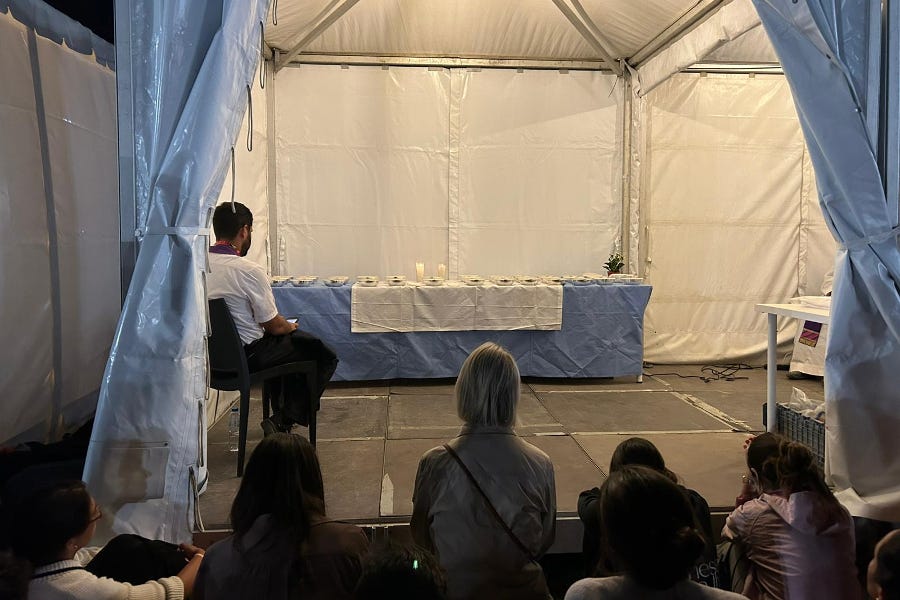
The priest said that he believes that what Dudzik saw was an anomaly.
“For some reason, these instructions were not followed in the tent that has appeared in that photograph. But this was an exception,” he argued.
The grey boxes in which ciboria were stored were donated to World Youth Day, and were not used for any other purpose, the priest explained.
“The only way to transport 6,000 ciboria was in boxes, but every care was taken to do so with the utmost dignity. They weren’t pretty, but it was the solution we found. Regarding the rest, only nuns were involved in cleaning the ciboria, weighing the hosts, counting them, putting them in the ciboria and packing them in the boxes. The ciboria were designed so that they could be safely stacked, without crushing the hosts inside.”
There were also instructions given by organizer that the there should be two people present in the tents at all times, to make sure nothing went amiss.
“There was to be somebody in adoration the whole time, and when possible, we also had a priest in the tent to hear confessions,” the priest explained.
But Dudzik told The Pillar that for a while, she and her friends were the only ones in the tent.
“When we were there the only other people were the two who were kneeling and praying, but they left soon after we started kneeling and praying. They could have been behind the tent, or somewhere else, but we couldn’t see them.”
Dudzik’s experience contrasts with what Mariana Silva, who was on duty as an extraordinary minister of the Eucharist, witnessed in her sector.
“There were people constantly on watch, and warning other people who might be coming past, pointing out that the Blessed Sacrament was there; the candles were lit the entire time; there were always people there praying,” Silva said.
“I think that, in as far as is possible in a situation like this, it was done with great care and consideration for sanctity.”
Silva and her husband Miguel spent the entire night of Aug. 5 near one of the tents containing the Eucharist. In the morning, they offered to help remove the ciboria from the grey boxes.
“The ladies who were in charge of the tent thanked us, but declined, saying that only they had permission to do so. And when time came to distribute Communion, even though we had been there with them all night, they still double-checked our credentials”.
“What I saw that night was an atmosphere of great reverence. The ladies on duty often warned passersby that The Lord was present in the tent, many people came by to pray in adoration,” Silva said.
The only situation that was out of the ordinary that I witnessed was when a paramedic who was stationed in a nearby tent approached the table with the ciboria. She was clearly curious as to what was going on, but when she put out her hand to open one of them to see what was inside, one of the ladies immediately stopped her and explained the situation”.
Photographs sent to The Pillar by other pilgrims who were at the vigil suggest that the situation witnessed by Dudzik and her friends seems to have been an exception, not the rule.
‘Not perfect,’ but ‘not sacrilege’ either?
Fr. Sean Gough was present at the vigil in Portugal, with a group from the archdiocese of Birmingham, England.
The young priest, who is known for having been questioned by police for silently praying in front of an abortion clinic in the UK (charges were subsequently dropped), took to social media to respond to Catholics critical of World Youth Day.
Speaking to The Pillar, Gough said that the experience of the vigil was moving, even though there were aspects that were not perfect.
“I thought that 1.5 million people coming together for adoration of the Blessed Sacrament, and Holy Mass, was an incredible thing to see, and it is something those young people will never forget.”
“There were certain aspects of it that were not perfect, and one of those was that the Eucharist was being kept in plastic stackable boxes.”
“It wasn’t ideal, but generally speaking an effort was made to treat the Eucharist with dignity: there were tents, they were carpeted, they had tables, they had altar cloths, they had lamps, candles, there were people there keeping it safe, people were stopping and adoring the Lord. If I was to change one thing about it, it would be that either the boxes should have been veiled, or maybe the ciboria should have been taken out of the boxes, and put into more reverent place,” he said.
“However, people have been reacting with words like ‘blasphemy’, ‘sacrilege’, the need to do reparation, and all this sort of thing, which is way out of proportion. It wasn’t perfect, but my exasperation was the result of the incredible overreaction people were having, and not being able to see, for the sake of that, the great joy involved, the immense joy that 1.5 million people got together so that they could go to adoration of the Blessed Sacrament, and to Holy Mass with the pope; that they were willing to spend 24 hours in 35º heat, sleep on open soil, just for that reason. That, to me, was the takeaway from that event, and all that the internet went crazy about was one shortcoming.”
While they were likely in different sectors during the vigil, the English priest confirmed Dudzik’s description of a festive atmosphere near the tents, but he said that he did not find that shocking — and the many people were unaware the tents contained the Eucharist.
“The tent was there for Mass in the morning, so that people could get Holy Communion at Mass. It clearly wasn’t there so that people could have a chapel to adore in their sectors. There was no marking on the outside saying it was a chapel, or anything like that. It was just a place out of practicality to reserve the Blessed Sacrament overnight, so that during Mass Holy Communion could be distributed.”
“When they noticed, people were stopping, kneeling, and praying, but most didn’t realize, so they were continuing with the joyful atmosphere that was generally present in World Youth Dday . People were dancing and singing, and playing instruments. That’s true. But they weren’t doing it out of disrespect, I think people just didn’t realize,” he said.
Gough also encouraged patience toward pilgrims without much understanding of the Eucharist.
A lot of pilgrims “were being sponsored to go to WYD because maybe they were in need of some evangelization, so somebody might not have recognised the importance of not smoking outside the tent. But there has to be a sense of proportion as well — lots of people were stopping, praying kneeling, adoring. I spent quite a bit of time there, and lots of people came when they noticed the Lord, they stopped and prayed.”
“Just because not everything is perfect, that doesn’t make everything bad, I would say,” he concluded.
A proxy for liturgy fights?
In many ways it would seem that the discussion over this aspect of World Youth Day has become a proxy for other, deeper disagreements, and the so-called liturgy wars.
Many of those who made criticism online or in the media, also questioned the use of extraordinary ministers of Communion, or the idea that at large-scale Catholic events, the Eucharist should be distributed at all.
For his part, a Portugese priest close to World Youth Day said that extraordinary ministers were logistically necessary.
“It wouldn’t have been possible to have the priests concelebrating near the altar and also distributing Communion two kilometers away. Priests did give Communion nearer the altar, and I know that some priests decided from the start that they would not concelebrate, and would stay with their communities, and in some cases they helped distribute Communion, as did the priests who had been hearing confession,” said the priest, who requested anonymity because he was not authorized to speak on the record.
As for the possibility of not distributing Communion, he considered that prospect — but said that in his view, the distribution of the Eucharist was of spiritual value.
“I don’t agree. I understand that it would not be a serious problem if there was no distribution at a large event like this, if it was logistically impossible, and that Mass would still be valid and have a spiritual effect on participants.”
“But to say that we are having Mass but the faithful can’t receive Communion does not make sense from a theological or liturgical perspective.”
Canon law stipulates that Catholics who are not prohibited by law must be admitted to Holy Communion; canon and liturgical law generally presume the Eucharist will be distributed to all Catholics disposed and inclined to receive it at Mass, with no specific provisions to the contrary.
“Of course, those who take the opposite view will always find their own arguments, but this has been the position of the Holy See,” the priest said.
Speaking to The Pillar, Dudzik said she is aware that her Instagram post is being used to criticize the concept of World Youth Day, but maintains that was not her intention.
“I work in media, so I know that whenever you say something it is going to be twisted, and it’s going to be used in different ways. This morning [Wednesday] I posted about how beautiful WYD was, and some people have already gotten mad at me, saying I posted just yesterday about this terrible thing that happened.”
“But I’ve been posting all week about how beautiful it was; I don’t think it was a failure. We were able to see the pope up close, that was wonderful, something I didn’t know I would ever experience in my lifetime.”
On the other hand, she said, “if you were coming for theological substance, I do think it was lacking. I think that the message that we got was to rise up, to be like Mary, and not be afraid, which was a wonderful message, but we weren’t given any real clear instruction on how to do that, or why, or what theological backing that has. So I do think that the theological aspect of it could be improved upon. Again, I understand that there was a huge audience, people from so many countries, it is definitely hard to witness to so many people,” she added.
“I also think that WYD showed that the Catholic Church is truly universal, and that’s a beautiful thing. My words are not meant as an attack on WYD as a whole. There were abuses, but if I didn’t think it was beautiful, I wouldn’t have gone.”
Comments 58
Services Marketplace – Listings, Bookings & Reviews





